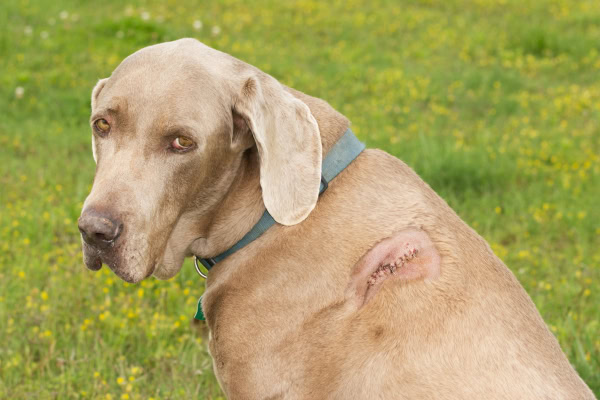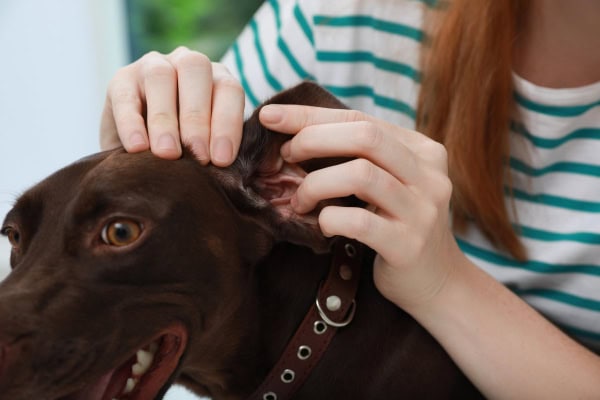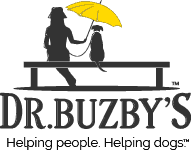If you are wondering, “Can I put Aquaphor on my dog?” search no further. Integrative veterinarian Dr. Julie Buzby discusses 11 situations where you should or should not use Aquaphor on your dog. Plus, she addresses the safety of Aquaphor for dogs and whether or not it is ok if dogs lick Aquaphor.

If you are like me, you probably have several containers of Aquaphor scattered around the house. That stuff is great for chapped lips, dry hands, diaper rashes, and so much more! But what about for your dog? Can you put Aquaphor on your dog too?
Well, it turns out the answer is…it depends. Aquaphor works well for some conditions in dogs, but shouldn’t be used for others.
Lets take a look at 11 scenarios where you might be tempted to use Aquaphor and discuss whether the answer is “yes,” “no,” or “maybe.” But first, a brief introduction to this multi-use ointment and its safety for dogs.
What is Aquaphor?
Aquaphor Healing Ointment® is a human skin care product that, according to their website, “creates a protective barrier to prevent moisture loss” and “creates an ideal healing environment for the skin”. It is a petroleum jelly product that also contains mineral oil, ceresin, lanolin alcohol, panthenol, glycerin, and bisabolol.
Is Aquaphor safe for dogs?
For many conditions, Aquaphor is safe for dogs and can be used as a home remedy. It doesn’t contain ingredients that are toxic to dogs. This means if a dog licks a small amount of Aquaphor off his or her nose, paws, or skin, it usually is not a concern.
However, if a dog ingests a large amount of Aquaphor, such as part of a tub of it, the dog may experience digestive upset (nausea, vomiting, or diarrhea). If this happens, please let your veterinarian know immediately.
Now let’s take a look at 11 situations where you might be tempted to reach for the Aquaphor and whether or not that is a good idea.
1. Can I put Aquaphor on my dog’s paw pads? YES
A dog’s paw pads should be smooth and free from cracks. However, sometimes dogs develop dry or cracked paw pads, especially if they spend a lot of time outside on rough terrain, are exposed to temperature extremes, or suffer a dog paw pad injury. Additionally, dogs may develop paw pad hyperkeratosis. In this condition, the paw pads become thickened and rough, and they may have keratin fronds (carpet-like projections) on the edges.
Paw pad problems are a situation where Aquaphor can potentially be helpful. However, if your dog’s paw pads are painful, have deep cracks, or might be infected, contact your veterinarian.
How to apply Aquaphor to dog paw pads
If you want to try some Aquaphor on cracked dog paws, first clean the paw pads with soap and water. This removes dirt trapped in the cracks that could lead to irritation or infection. In the case of hyperkeratosis or very thick and dry paw pads, it can also be helpful to soak them in Epsom salts and warm water for 10-15 minutes. (Don’t let your dog drink the Epsom salt and water mixture.)
Then apply a thin coat of Aquaphor to each affected paw pad. It is helpful to do this at a time when your dog is sleeping or ready to lie down for awhile. If your dog is walking around a lot, the Aquaphor is more likely to rub off on the floor.
Keep your dog inside for at least 30 minutes after applying the Aquaphor. This allows time for the skin to absorb it. Otherwise, if your dog goes outside right after you put the Aquaphor on, he or she could end up with dirt or debris stuck to the feet.
Some dog parents may also want to apply a sock or dog bootie over the Aquaphor. However, this generally isn’t necessary, and can sometimes cause issues. Older dogs with poor mobility may have trouble walking around in booties, and wearing socks may be stressful for some dogs. Plus, booties or socks can trap moisture, worsening conditions such as a dog paw yeast infection.
2. Can I put Aquaphor on my dog’s dry nose? YES
It is an old wives tale that healthy dogs have cold, wet noses and sick dogs have warm, dry noses. However, this doesn’t mean it is normal for dogs to have a cracked and dry nose or dog nose hyperkeratosis either. Sometimes a dog’s dry nose can benefit from some extra moisture.

If your dog’s nose appears mildly cracked or dry, you can apply a small amount of Aquaphor the surface of the nose a few times a day. (Be careful not to occlude the nostrils with the ointment.) Aquaphor will moisturize your dog’s dry nose and help it heal.
However, if the cracking gets worse or continues after you have been using Aquaphor, please make an appointment with your veterinarian.
3. Can I use Aquaphor to prevent urine scald? YES
If urine sits in contact with the dog’s coat and skin for long periods of time, it can weaken the skin barrier and possibly “burn” the skin. Not only is urine scald in dogs extremely painful, but the area can also become infected.
Using Aquaphor on areas in contact with urine can create a barrier to help the urine “roll off” the skin and prevent scalding. Thus, it is particularly useful for dogs with incontinence in dogs, paralyzed dogs who leak urine or can’t get up to urinate, and dogs who frequently wear a belly band or diaper.
Before applying Aquaphor to your dog’s skin, be sure to gently clean the area. Also, remember that using Aquaphor does not replace the need to change your dog’s blankets when soiled and clean him or her up. Practicing good hygiene for your dog is still the number one way to prevent urine scald.
4. Can I put Aquaphor on pressure sores? YES
Dogs—especially senior dogs—can develop pressure sores from lying on hard surfaces all the time. This occurs more commonly in large dogs, dogs who live in homes with hard floors, and dogs who don’t tend to get up or change position frequently due to pain or poor mobility.
Pressure sores in dogs tend to form in areas where there are “boney prominences” like the elbow or hip. If your dog loses hair or develops tough skin in these areas, he or she may be forming a pressure sore.
Applying Aquaphor to a mild pressure sore can slow progression by keeping the skin soft and moist. However, Aquaphor will not completely prevent or stop the callus from developing. You will need to encourage your dog to lie on soft surfaces and help him or her change positions too.
If your dog’s pressure sore worsens or begins to crack or change to an open wound make an appointment with your vet. Do not apply Aquaphor to painful, infected, or deep pressure sores unless your veterinarian says it is okay.
5. Can I use Aquaphor for water bowl contact dermatitis? YES
Some dogs develop red irritated skin on the bottom of their mouth and chin from their water bowl. This most often occurs when dogs have an allergy to one of the materials in a plastic or stainless-steel water bowl.

The best treatment option is to change your dog’s water and food bowl to a different material. Ceramic bowls are usually best. Some dogs may also need antibiotics or allergy medications. Plus, applying Aquaphor to the chin and other affected areas can help prevent further irritation while the skin heals.
6. Can I put Aquaphor on my dog’s dry itchy skin? MAYBE
Just like humans, dogs may sometimes develop dry and itchy skin. However, most of the time if your dog has irritated itchy skin, it is due to an underlying problem. Some common culprits include food, flea, or environmental allergies, parasites, or yeast or bacterial skin infections (pyoderma in dogs). Aquaphor isn’t going to address any of those root causes.
Therefore, if your dog’s skin is red, raw, irritated, swollen or itchy, don’t use Aquaphor. Instead, make an appointment with your veterinarian. He or she can determine the cause of your dog’s dry, itchy skin and develop a treatment plan.
On the other hand, if your dog has a small patch of dry skin that doesn’t look irritated and isn’t itchy, it is ok to try a thin layer of Aquaphor. But consult your vet if it gets worse or doesn’t improve.
7. Can I put Aquaphor on a burn? MAYBE
Burns in dogs happen for a variety of reasons. They may get thermal burns due to walking on hot pavement or being exposed to a heating pad or flame. Or contact with ice melt chemicals or other caustic substances may cause a chemical burn.
Each burn is different and requires a different treatment plan. The type, severity, and location of the burn can all impact your veterinarian’s recommendation. Therefore, applying Aquaphor to a burn without consulting your veterinarian first is not recommended—especially because applying Aquaphor in the first 24 hours of a burn may trap heat and make the burn worse.
After evaluating the burn, the veterinarian may recommend a specific medication or bandage to help the skin heal. In cases of minor burns or after a burn has begun to heal, your veterinarian might say you can put Aquaphor on the burn. But don’t do it until you get the “okay” from your vet.
8. Can I put Aquaphor on my dog’s wounds? MAYBE
If a dog has a minor cut or scrape, Aquaphor may be helpful to keep the skin moist and promote healing. Or if your dog has an old wound that is in the final stages of healing, Aquaphor can help reduce itching and soothe the skin around the scar.
But, if your dog has a large open wound or cut, it is best to consult your veterinarian before applying Aquaphor. The vet may need to clean and stitch the wound (and possibly insert a drain) in order for it to heal properly. Or he or she may recommend using specific ointments or bandaging the wound to keep it clean and dry. Then once the wound heals some, you might be able to use Aquaphor on it.
9. Can I put Aquaphor on my dog’s stitches? MAYBE
You should always ask your veterinarian if it’s okay to put Aquaphor on the stiches before doing so. Some suture material can dissolve faster in high moisture environments, which could lead to the incision opening up. Or, the veterinarian may want the incision to stay clean of any type of ointment for the first few days after surgery.

However, in some cases, applying a thin layer of Aquaphor to your dog’s incision line twice a day may help keep the skin moist, promote healing, and prevent itching.
If your veterinarian says it is okay to apply Aquaphor to the incision, it is crucial to monitor your dog closely after putting it on. Some dogs may be tempted to lick the Aquaphor—therefore, also licking their incision. This can lead to negative outcomes like inflammation, infection, or failure of the sutures.
10. Can I use Aquaphor for my dog’s hot spots? NO
Hot spots in dogs can appear seemingly overnight. They usually look like an inflamed area on the skin with a moist reddish to yellowish surface. Hot spots occur where a dog repetitively itches, licks, or otherwise traumatizes the skin. Allergies, insect bites, ear infections, and pain are all common culprits.
If you suspect your dog has a hot spot, the best plan is to make an appointment with your vet. You should not put Aquaphor on a hot spot because it will make the hot spot worse, not better. Hot spots need to dry up to heal, and Aquaphor traps moisture, slowing the healing process.
11. Can I put Aquaphor on or in my dog’s ears? NO
Ear infections (otitis in dogs) develop for a variety of reasons, including the dog having moisture trapped inside the ear canal. Therefore, you should not use Aquaphor in your dog’s ears as it will likely accentuate the problem, not resolve it. Aquaphor traps moisture inside the ear canal and prevents the air flow needed to dry the ear. This creates the perfect environment for bacteria or yeast to multiply and further irritate the ear canal.
Instead, if your dog is shaking his or her head and scratching at the ears, please consult your veterinarian. He or she can examine your dog’s ears and run diagnostics to find the cause of the ear infection. Plus, your vet can teach you how to clean a dog’s ears and prescribe any medication needed to treat the ear infection.
If your dog has cuts or scabs near the ears from scratching, you should not put Aquaphor on them either. While it isn’t technically in the ear, Aquaphor applied around the ear canals or on the ear flap can still trap moisture in the area.

What about using Vaseline for dogs?
Since Aquaphor and Vaseline are similar petroleum-based ointments, people often use them interchangeably. But there are some cases where one product may be a better choice for your dog than the other.
Aquaphor has lanolin in it and Vaseline doesn’t. This means Aquaphor may promote faster healing of minor scrapes or dry noses and paw pads. On the other hand, Vaseline forms a thicker barrier, which can be advantageous for protecting the skin or covering minor cuts. But from a general perspective, the answers here for Aquaphor would also pertain to Vaseline.
When in doubt, talk to your vet
Aquaphor can be a handy home remedy for dry noses, paw pads and skin. Plus, it is great for preventing urine scald and helping manage minor pressure sores. However, because it traps moisture against the skin, it can sometimes cause more harm than good.
If you are unsure if you should use Aquaphor on your dog, the best thing you can do is consult your veterinarian. And if at any point when you are using Aquaphor, your dog’s condition worsens, stop using it and give your vet a call.
Have you put Aquaphor on your dog?
Please share below.


We welcome your comments and questions about senior dog care.
However, if you need medical advice, diagnosis, or treatment, please contact your local veterinarian.